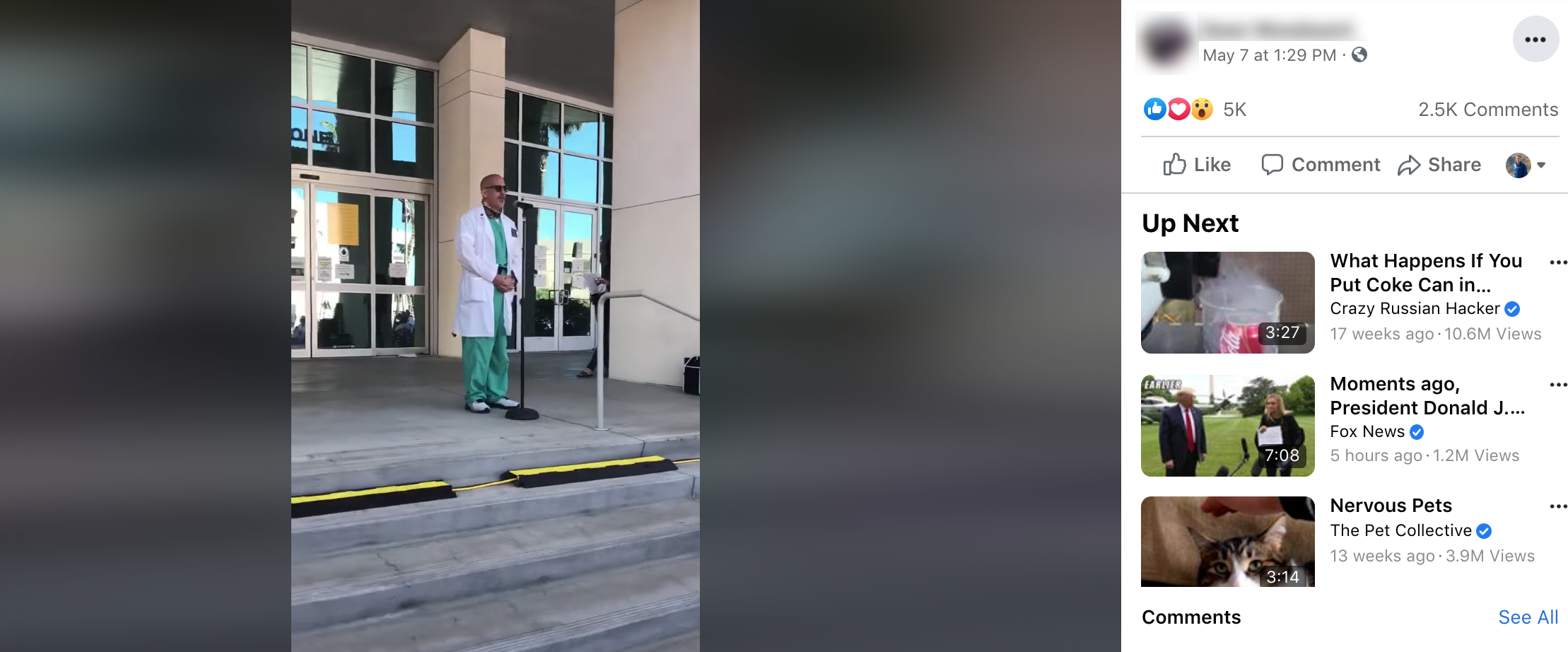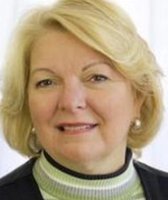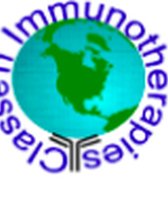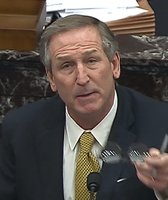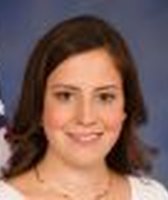Get PolitiFact in your inbox.
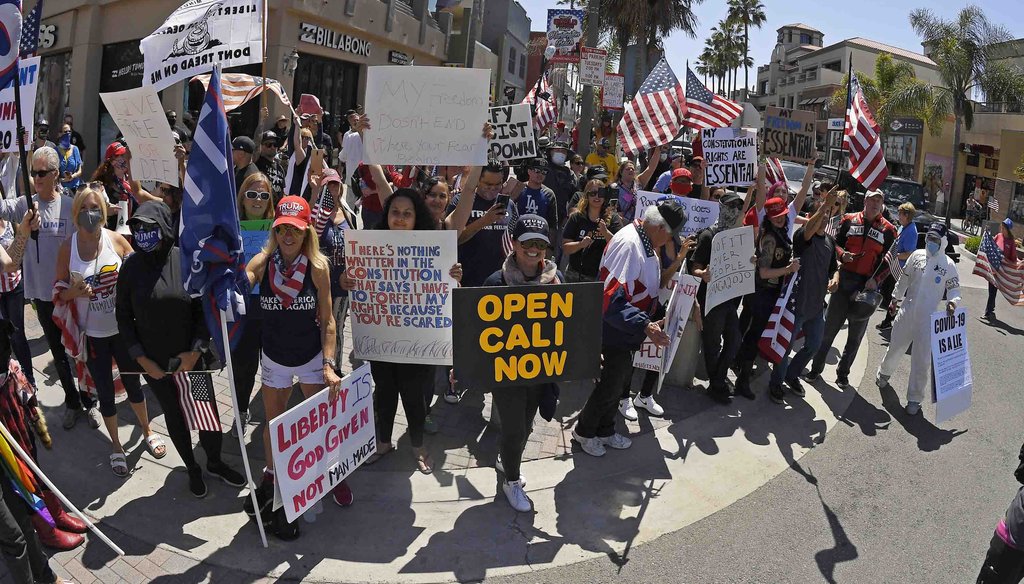
In this April 17, 2020, file photo, protesters demonstrate against stay-at-home orders that were put in place due to the COVID-19 outbreak, in Huntington Beach, Calif. (AP)
If Your Time is short
-
A popular Facebook video shows a Southern California doctor giving a speech at a protest demanding local officials reopen the economy.
-
The speech contains several misleading and inaccurate claims about the government’s response to the coronavirus pandemic, the severity of the virus and how to slow its spread.
Protests calling for state and federal governments to reopen have become a source of misinformation about the coronavirus pandemic.
A May 7 clip on Facebook shows a doctor giving a six-minute speech about California’s response to the coronavirus pandemic. In it, the doctor makes several misleading claims about the severity of the virus and the efficacy of social distancing and face masks.
"My name is Dr. Jeff Barke and I’m here representing thousands of physicians across the country whose voices are being silenced because we don’t agree with the mainstream media and the experts who are telling us what to do," he says at the start of the video.
The article was flagged as part of Facebook’s efforts to combat false news and misinformation on its News Feed. (Read more about our partnership with Facebook.)
(Screenshot from Facebook)
Using Google Maps, we determined that the location of the video is the steps of the Riverside County government office in downtown Riverside, Calif. Protesters congregated in the city, which is about 55 miles east of Los Angeles, on May 5 to demand county supervisors lift local stay-at-home orders. Barke is a physician who runs a primary care concierge service in Newport Beach, Calif.
While some of Barke’s claims are accurate, several of the claims are misleading or false. We fact-checked five of them below.
‘What if quarantining the healthy doesn’t save lives?’
This is inaccurate. We rated a similar claim False.
The science behind social distancing is clear: The novel coronavirus primarily spreads via person-to-person contact. So the less contact you have, the less likely you are to spread or contract the coronavirus.
That’s the reasoning behind several state stay-at-home orders, including California’s. And, while it’s difficult to assess the exact impact of social distancing policies, data and preliminary research suggest they’re working.
According to numbers published by the Los Angeles Times, the seven-day average of coronavirus deaths per day has remained relatively constant since mid-April. Gov. Gavin Newsom ordered a statewide shelter-in-place order March 19.
RELATED: To stop coronavirus in its tracks, here’s your guide to 5 degrees of separation
Researchers at the Fred Hutchinson Cancer Research Center used a mathematical model to measure the effectiveness of social distancing measures in a mid-sized American city like Seattle. An early release of the upcoming study notes that "while social distancing interventions were in place, 20% of new cases and most hospitalizations and deaths were averted, even with modest reductions in contact among adults."
Still, social distancing and self-isolation are just stopgap measures until there is a treatment or vaccine for the coronavirus.
"It’s important to emphasize that we’re not out of the woods yet," said Robert Redfield, director of the Centers for Disease Control and Prevention, in his May 12 testimony to the Senate. "We need to stay vigilant with social distancing. It remains an imperative."
‘What if wearing a mask in public is not effective?’
This is inaccurate. Official guidance from public health experts says wearing a mask in public can prevent the spread of the coronavirus.
In an email to PolitiFact, Barke sent us two articles as evidence for his claim: one from CNN and one from Real Clear Politics. Both highlight how, in the early days of the pandemic, public health officials did not advise healthy people to wear face masks because there were shortages for health care workers treating COVID-19 patients.
However, that guidance has changed.
The CDC now advises anyone who goes out in public to wear a mask. Since infected people may not show symptoms for up to 14 days, the goal is to prevent them from unwittingly spreading the coronavirus through coughs and sneezes.
Face masks do not block some very fine particles in the air that may be transmitted by coughs or sneezes. That means they’re not a reliable way of preventing someone who’s wearing one from contracting the airborne coronavirus particles and getting COVID.
RELATED: To fight COVID-19, CDC now says wear masks in public
But, since masks do prevent the spread of larger respiratory droplets, they are effective at preventing someone from spreading the virus to other people. Different kinds of face masks offer varying degrees of protection.
Many health care providers use N95 respirators, which filter out at least 95% of airborne particles. Generic surgical masks are also effective at blocking respiratory droplets.
However, the CDC does not advise the American public to use either kind of mask as a COVID-19 prevention measure, since there have been shortages around the country. Instead, it advises people to wear cloth face coverings in public.
"Given the current crisis, and lacking an alternative, many layers of densely woven fabric would be the most effective, because it allows for lots of voids in the layers where particles can be trapped," Richard Peltier, an assistant professor of environmental health sciences at the University of Massachusetts-Amherst, previously told PolitiFact.
‘Never in the history of this great republic have we quarantined the healthy’
This is inaccurate. While official federal policy on social distancing is new to the coronavirus pandemic, similar measures were taken at the local level to contain the spread of the 1918 influenza. And research shows they worked.
A 2007 study conducted by researchers at the University of Michigan Medical School and the CDC found that the greatest reductions in weekly death rates due to the influenza occurred in cities that implemented measures like quarantine, self-isolation, school closures and social distancing. New York City was one example.
"Typically, individuals diagnosed with influenza were isolated in hospitals or makeshift facilities, while those suspected to have contact with an ill person (but who were not yet ill themselves) were quarantined in their homes with an official placard declaring that location to be under quarantine," the authors wrote. "New York City mounted an early and sustained response to the epidemic and experienced the lowest death rate on the Eastern seaboard."
RELATED: Laura Ingraham wrong about 'no real scientific basis' for social distancing
Another study, published by the Proceedings of the National Academy of Sciences, came to a similar conclusion. The authors found that cities that employed early, layered interventions had death rates 50% lower than cities that didn’t take similar steps.
"Non-pharmaceutical interventions have been shown to help reduce the overall number of cases and virus-related mortality," David Hamer, professor of global health and medicine at Boston University, told PolitiFact.
‘The fatality rate of this virus is in the ballpark of a bad seasonal influenza’
This is misleading. While it’s hard to estimate the precise fatality rate of COVID-19, public health experts have said it appears to be higher than the seasonal flu.
As evidence to support his claim, Barke sent us three links: one to a post on a job site for biotechnology jobs, one to a post from Medical News Today and one to a story on a website called Just the News. While they all address the difficulty of nailing down an exact fatality rate for the coronavirus, none of them prove Barke’s claim.
According to researchers at Johns Hopkins University, the case fatality rate of COVID-19 is 6% in the U.S. They derived that statistic by dividing the number of deaths by the number of confirmed coronavirus cases.
That’s an imperfect measurement, as many mild cases of COVID-19 go unreported. If those cases were counted, the case fatality rate would decrease. But, as we’ve reported, the death toll may also be higher than we know.
RELATED: Is COVID-19 America's leading cause of death?
Given that uncertainty, there is no indication that the coronavirus has a similar fatality rate to the flu, which usually hovers under 0.1% and is calculated annually using a mathematical model. Available data suggest that it is more lethal than the flu.
"It is surprisingly mild only to those who were not listening to competent epidemiologists, and it is in fact considerably worse than seasonal flu," Marc Lipsitch, professor of epidemiology at the Harvard T.H. Chan School of Public Health, previously told PolitiFact.
‘As we see unemployment increase to Depression levels, we also see suicide increase, we see domestic violence increase, we see child abuse increase, we see alcohol and drug abuse increase’
These claims are accurate.
In April, the U.S. unemployment rate jumped to 14.7% — the highest level since the Great Depression. Businesses around the country were forced to close their doors to comply with stay-at-home orders, and 20.5 million people lost their jobs.
That economic uncertainty has correlated with a spike in mental health concerns across the country.
The Meadows Mental Health Policy Institute, a Texas nonprofit, created models that show, as the economy continues to worsen because of the pandemic, suicides and drug overdoses will also tick up. That’s because researchers have established a link between economic instability and mental health problems.
Experts also say the coronavirus pandemic has created the circumstances for an increase in domestic violence and child abuse.
The New York Times reported on how hotlines and authorities around the world are getting more domestic violence calls. The American Psychological Association says that’s because "stress and social isolation can raise the risk of domestic violence."
"Before the pandemic, a survivor or victim could flee a violent situation by staying with a family member, going to a shelter or filing a protective order with the police," the organization wrote. "For many, such options aren’t easily available right now."
That risk extends to instances of child abuse, which organizations like the Rape, Abuse and Incest National Network have said are rising as children are isolated with their abusers. RAINN saw a 22% increase in calls to its hotline by the end of March, NPR reported.
Our Sources
ABC News, "Virus misinformation flourishes in online protest groups," April 21, 2020
American Psychological Association, "How COVID-19 may increase domestic violence and child abuse," April 8, 2020
American Society for Microbiology, "The Science of Social Distancing," April 9, 2020
Biospace, "Multiple Studies Suggest COVID-19 Mortality Rate May Be Lower Than Expected," May 7, 2020
California Department of Public Health, COVID-19, accessed May 14, 2020
Centers for Disease Control and Prevention, Coronavirus Disease 2019 (COVID-19): Symptoms of Coronavirus, accessed May 14, 2020
Centers for Disease Control and Prevention, Coronavirus Disease 2019 (COVID-19): Use of Cloth Face Coverings to Help Slow the Spread of COVID-19, accessed May 14, 2020
Centers for Disease Control and Prevention, How CDC Estimates the Burden of Seasonal Influenza in the U.S., accessed May 14, 2020
CNN, "WHO stands by recommendation to not wear masks if you are not sick or not caring for someone who is sick," March 31, 2020
Emerging Infectious Diseases, "Evaluating the Effectiveness of Social Distancing Interventions to Delay or Flatten the Epidemic Curve of Coronavirus Disease," April 28, 2020
Facebook video, May 7, 2020
Google Maps, accessed May 14, 2020
Johns Hopkins University Coronavirus Resource Center, Mortality Analyses, accessed May 14, 2020
Journal of the American Medical Association, "Nonpharmaceutical Interventions Implemented by US Cities During the 1918-1919 Influenza Pandemic," Aug. 8, 2007
Just the News, "Fauci offers more conservative death rate in academic article than in public virus briefings," March 31, 2020
KQED, "California Gov. Gavin Newsom Issues Statewide Shelter-in-Place Order," March 19, 2020
KQED, "Flattening the Curve Bought California Time to Prepare for Future Surge," May 11, 2020
The Lancet, "COVID-19, unemployment, and suicide," May 1, 2020
Los Angeles Times, "After hours of debate, Riverside County postpones vote to reopen amid coronavirus outbreak," May 5, 2020
Los Angeles Times, "Tracking coronavirus in California," May 13, 2020
Meadows Mental Health Policy Institute, Projected COVID-19 MHSUD Impacts, Volume 1: Effects of COVID-Induced Economic Recession (COVID Recession) – April 28, 2020, Full Version
Medical News Today, "Why are COVID-19 death rates so hard to calculate? Experts weigh in"
The New York Times, "A New Covid-19 Crisis: Domestic Abuse Rises Worldwide," April 6, 2020
The New York Times, "The Untold Story of the Birth of Social Distancing," April 22, 2020
The New York Times, "U.S. Coronavirus Death Toll Is Far Higher Than Reported, C.D.C. Data Suggests," April 28, 2020
NPR, "Child Sexual Abuse Reports Are On The Rise Amid Lockdown Orders," April 28, 2020
Personal Care, Meet Dr. Jeffrey Barke, accessed May 14, 2020
PolitiFact, "Are homemade face masks effective against COVID-19?" April 1, 2020
PolitiFact, "COVID-19 skeptics say there’s an overcount. Doctors in the field say the opposite," April 14, 2020
PolitiFact, "Fact-checking ‘Plandemic’: A documentary full of false conspiracy theories about the coronavirus," May 7, 2020
PolitiFact, "Has "Safer At Home" in Wisconsin saved 300+ lives?" May 1, 2020
PolitiFact, "Laura Ingraham wrong about 'no real scientific basis' for social distancing," May 6, 2020
PolitiFact, "Tucker Carlson says coronavirus isn’t as deadly as we thought. Experts disagree," May 4, 2020
PolitiFact, "Why it’s hard to estimate the coronavirus death rate this early," March 6, 2020
Proceedings of the National Academy of Sciences, "Pandemic influenza: Studying the lessons of history," May 1, 2007
Psychology Today, "Why Should We Believe the Science Behind Social Distancing?" March 27, 2020
Real Clear Politics, "FLASHBACK MARCH 2020: Fauci Says ‘There's No Reason To Be Walking Around With A Mask,’" May 12, 2020
Rev, Dr. Anthony Fauci & CDC Director Senate Testimony Transcript May 12
U.S. Food and Drug Administration, N95 Respirators and Surgical Masks (Face Masks), accessed May 14, 2020
The Washington Post, "The coronavirus pandemic is pushing America into a mental health crisis," May 4, 2020
The Washington Post, "U.S. deaths soared in early weeks of pandemic, far exceeding number attributed to covid-19," April 27, 2020
The Washington Post, "U.S. unemployment rate soars to 14.7 percent, the worst since the Depression era," May 8, 2020

